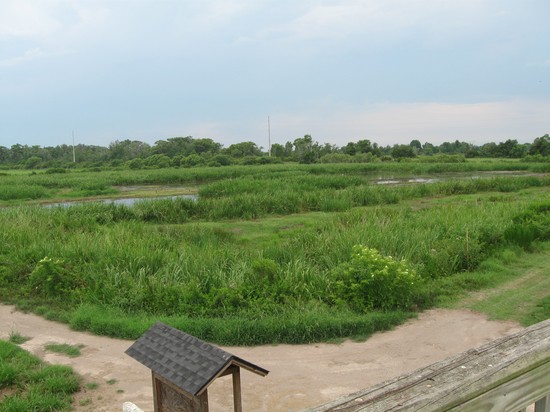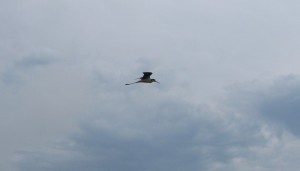Looking for Least Bitterns at Altamaha
Least Bitterns are not rare in Georgia. They breed here, mostly along the coast, though there is some inland nesting. And apparently a few may even winter here. But, embarrassingly, I had never seen one in Georgia. I bird the coast mostly in fall and winter, so I’ve just never been where they are when they are here.
But that changed this weekend. My wife, daughter, and I joined my dad and stepmother in Savannah for a long weekend. I knew I wouldn’t be able to do much birding, but I did want to set aside a little time to try to fill this empty box in my state checklist. Thus, a trip to Altamaha WMA was in order.

View of Altamaha WMA from the observation tower
Altamaha is a fantastic place. The impoundments that formerly grew rice are now managed for ducks and other wildlife. From my vantage point on an observation tower I could see that the place was teeming with birds. Boat-tailed Grackles and Red-winged Blackbirds were flying and calling all over the place. Every heron and egret that you would expect, even a couple of Black-crowned Night-herons, could be seen. Glossy Ibis outnumbered their white cousins. Well, on the ground at least. There were always some White Ibis in the air above, from pairs to large skeins. A pair of Black-bellied Whistling-ducks would fly around every now and then.
You couldn’t help but smile at the family of cute, fuzzy, black Common Moorhen chicks. A single, resplendent Purple Gallinule made a short appearance. I can’t believe I left the digiscoping adapter in the car, making it tough to get any pictures.
The most interesting thing, behavior-wise, was the displaying of some Black-necked Stilts. I could see two stilts feeding in the impoundment on one side. But every few minutes one of them would take off and fly around slowly in a circle, all the while calling kek kek kek incessantly. When it was done, a stilt from the other side of the dike would respond by doing the same thing. At the time, I thought that perhaps the raised dike was the boundary between two territories and that these were border disputes. More on this later.But no Least Bittern. I scanned and rescanned the edges of the impoundments, hoping to spot one clinging to the vegetation, but to no avail. I only had a few minutes left, due to an appointment elsewhere, when I saw a small bird fly into a cluster of reeds. It was out of the corner of my eye, so all I was able to make out were large, buffy wing patches. That was enough to know it was my Least Bittern! I got my scope on the spot in time to see the bird, partially obstructed, clamber deeper into the vegetation and out of sight.
Whew. It was a great relief to finally see it, just in the nick of time. But looking back, I think I enjoyed the stilts even more. I had never expected to see such a shorebird display here. The arctic tundra, sure, but not in Georgia. That gives me hope that I haven’t become a crazed, list-obsessed birder. Not totally, anyway.
Back to the stilt display. After doing some research later, I think I was wrong about what they were doing. They may have been mobbing me. They were flying nearby or right over me, no more than twenty feet above my head. That could easily be explained, though, if the dike were the territory boundary with the tower at the corner. But both The Shorebird Guide and Pete Dunne mention that stilts will aggressively defend their territory against intruders, including humans, by giving incessant flight calls. I guess they took offense to my presence. I honestly didn’t think it was me at the time, but if it was, hopefully I didn’t disturb them too badly.
And now I’ve learned something new. Gotta love birding.
Tags: Altamaha WMA
 Posted in
Posted in 




